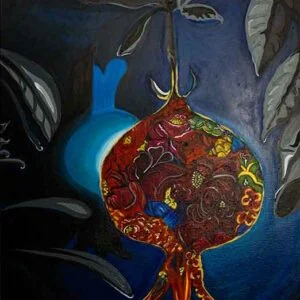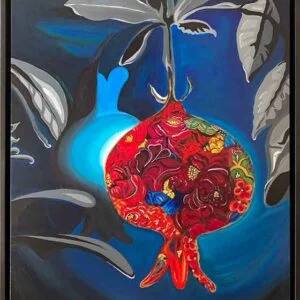THE JEWEL OF WINTER
ACRYLIC ON CANVAS 55X90CM
Pomegranates hold great symbolic significance in Greek mythology, especially in the epic tale of the abduction of Persephone, the goddess of vegetation, by Hades, the god of the Underworld. Having been abducted and imprisoned, Persephone was tricked into eating six pomegranate seeds by Hades which by the rules of Fates doomed her to spend six months of the year in the Underworld. This news devastated Persephone’s mother, Demeter, the goddess of fertility, who went into mourning that resulted in all things on Earth to stop growing. Her mourning only stopped when she was reunited with Persephone, who was released from the Underworld every six months of the year.
This mythos became the basis for the ancient Greeks’ explanation of the seasonal cycles. Spring and summer marked the reunion of the mother and daughter leading Earth to flourish and grow. While, winter and autumn was a result of Persephone’s return to the Underworld and Demeter’s subsequent mourning which made the Earth infertile. This led to the tradition in ancient Greece to offer pomegranates to the goddess Demeter in return for healthier crops and the longevity of Earth’s fertility.
This oeuvre honours the dichotomous nature and history of the Pomegranate, which in some faiths and cultures is considered a fruit of Paradise that signifies life and bountiful fertility. While on the other hand, it also serves as a symbol of death, infertility and the tragic fate of a revered Greek goddess.
THE JEWEL OF WINTER
ACRYLIC ON CANVAS 55X90CM
Pomegranates hold great symbolic significance in Greek mythology, especially in the epic tale of the abduction of Persephone, the goddess of vegetation, by Hades, the god of the Underworld. Having been abducted and imprisoned, Persephone was tricked into eating six pomegranate seeds by Hades which by the rules of Fates doomed her to spend six months of the year in the Underworld. This news devastated Persephone’s mother, Demeter, the goddess of fertility, who went into mourning that resulted in all things on Earth to stop growing. Her mourning only stopped when she was reunited with Persephone, who was released from the Underworld every six months of the year.
This mythos became the basis for the ancient Greeks’ explanation of the seasonal cycles. Spring and summer marked the reunion of the mother and daughter leading Earth to flourish and grow. While, winter and autumn was a result of Persephone’s return to the Underworld and Demeter’s subsequent mourning which made the Earth infertile. This led to the tradition in ancient Greece to offer pomegranates to the goddess Demeter in return for healthier crops and the longevity of Earth’s fertility.
This oeuvre honours the dichotomous nature and history of the Pomegranate, which in some faiths and cultures is considered a fruit of Paradise that signifies life and bountiful fertility. While on the other hand, it also serves as a symbol of death, infertility and the tragic fate of a revered Greek goddess.











